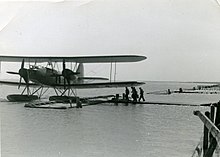|
Heinkel He 59
The Heinkel He 59 was a twin-engined German biplane designed in 1930, resulting from a requirement for a torpedo bomber and reconnaissance aircraft able to operate on wheeled landing gear or twin-floats. Development In 1930, Ernst Heinkel began developing an aircraft for the Reichsmarine. To conceal the true military intentions, the aircraft was officially a civil aircraft. The He 59B landplane prototype was the first to fly, an event that took place in September 1931,[2] but it was the He 59A floatplane prototype that paved the way for the He 59B initial production model, of which 142 were delivered in three variants. The Heinkel He 59 was a pleasant aircraft to fly; deficiencies noted were weak engines, limited range, small load capability, and insufficient armament. DesignThe aircraft was of a mixed-material construction. The wings were made of a two-beam wooden frame, where the front was covered with plywood and the rest of the wing was covered with fabric.[3] The box-shaped fuselage had a fabric-covered steel frame. The tail section was covered with lightweight metal sheets. The keels of the floats were used as fuel tanks - each one holding 900 L (240 US gal; 200 imp gal) of fuel.[3] Together with the internal fuel tank, the aircraft could hold a total of 2,700 L (710 US gal; 590 imp gal) of fuel. Two fuel tanks could also be placed in the bomb bay, bringing the total fuel capacity up to 3,200 L (850 US gal; 700 imp gal).[3] The propellers were fixed-pitch with four blades. OperationsDuring the first months of World War II, the He 59 was used as a torpedo- and minelaying aircraft. It was also serving with various Seenotstaffeln (Air Sea Rescue). It also helped land troops in Norway and Holland in the Spring of 1940. Between 1940 and 1941 the aircraft was used by four KüFlGr (Küstenfliegergruppe/Coastal reconnaissance group),[1] and in 1941-42 as a transport, air-sea rescue, and training aircraft. Some had been operated by the Condor Legion in Spain during the Spanish Civil War in 1936 as coastal reconnaissance and torpedo floatplanes. During the Battle of Britain, they were used to rescue German aircrew who had ditched in The Channel. The British claimed that because the air-sea rescue aircraft were being used for reconnaissance, they were legitimate targets despite carrying Red Cross markings.[3] Even before then some had been forced down by British aircraft.[4] Most of the 140 B-2s and B-3s built by Arado were later converted by the Walter Bachmann Flugzeugbau for air/sea rescue (He 59C-2 and D-1) or specialised training in navigation (He 59C-1, D-1 and N), torpedoe dropping (E-1) and photographic roles (E-2). All of these aircraft were unarmed except for the He 59N.[5] The Ilmavoimat (Finnish Air Force) rented four aircraft from Germany in August 1943. These were used to ferry long-range reconnaissance patrols behind enemy lines. They were returned to Germany four months later. OperatorsVariants
Specifications (He 59B-2)Data from Warplanes of the Third Reich [6] General characteristics
Performance
Armament
See also
Aircraft of comparable role, configuration, and era Related lists
References
Notes
Bibliography
External linksWikimedia Commons has media related to Heinkel He 59. |
||||||||||||||||||||||||
